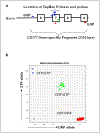An accurate genetic assay to identify human neutrophil antigen 2 deficiency
- PMID: 36308061
- PMCID: PMC9974537
- DOI: 10.1111/tme.12936
An accurate genetic assay to identify human neutrophil antigen 2 deficiency
Abstract
Objective: We aimed to develop accurate and user-friendly genetic assays to identify the inherited neutrophil antigen-2 (HNA-2) deficiency in humans.
Background: HNA-2 is one of the most important neutrophil antigens implicated in a number of human disorders. HNA-2 deficiency or HNA-2 null is a common phenotype observed in 3%-5% Americans. HNA-2 null individuals are at risk to produce isoantibodies (or alloantibodies) that play important roles in transfusion-related acute lung injury, immune neutropenia, and bone marrow graft failure. We previously demonstrated that the CD177 coding SNP 787A > T (c.787A > T) is the most important genetic determinant for HNA-2 deficiency. However, reliable genetic assays are not available for routine clinical laboratory application up to now.
Study design and methods: A novel polymerase chain reaction (PCR) strategy was used to determine genotypes of the CD177 SNP c.787A > T. In the simplified PCR assay, all allele specific primers and internal control primers were included in the same reaction, which ensures reliability of the assay. In addition, a novel high-throughput nested TaqMan assay was developed to determine genotypes of c.787A > T for large population genetic analysis of HNA-2 deficiency.
Results: CD177 SNP c787A > T genotypes of 396 subjects were 100% concordant among the single PCR reaction method, the nested TaqMan assay, and Sanger Sequencing analysis. Out of 396 subjects, all 18 donors with the CD177 STP homozygous genotype were HNA-2 null.
Conclusion: The novel PCR-based genotyping assay is accurate to identify HNA-2 deficient individuals and is suitable for clinical laboratories. In addition, the innovative high-throughput nested TaqMan assay will be useful for large-scale population screens and genetic studies of HNA-2 deficiency.
Keywords: CD177; HNA-2 deficiency; genetic assay; polymorphisms.
© 2022 The Authors. Transfusion Medicine published by John Wiley & Sons Ltd on behalf of British Blood Transfusion Society.
Conflict of interest statement
Figures



Similar articles
-
The nonconservative CD177 single-nucleotide polymorphism c.1291G>A is a genetic determinant for human neutrophil antigen-2 atypical/low expression and deficiency.Transfusion. 2019 May;59(5):1836-1842. doi: 10.1111/trf.15222. Epub 2019 Mar 3. Transfusion. 2019. PMID: 30828823 Free PMC article.
-
A novel nonsense mutation found in the CD177 gene of Thai individuals with the HNA-2 null phenotype.Transfus Med. 2020 Feb;30(1):30-36. doi: 10.1111/tme.12650. Epub 2019 Nov 28. Transfus Med. 2020. PMID: 31777111 Clinical Trial.
-
Genetic mechanism of human neutrophil antigen 2 deficiency and expression variations.PLoS Genet. 2015 May 29;11(5):e1005255. doi: 10.1371/journal.pgen.1005255. eCollection 2015 May. PLoS Genet. 2015. PMID: 26024230 Free PMC article.
-
Developments in the definition and clinical impact of human neutrophil antigens.Curr Opin Hematol. 2011 Nov;18(6):452-60. doi: 10.1097/MOH.0b013e32834babdd. Curr Opin Hematol. 2011. PMID: 21912255 Review.
-
Human neutrophil alloantigens systems.An Acad Bras Cienc. 2009 Sep;81(3):559-69. doi: 10.1590/s0001-37652009000300019. An Acad Bras Cienc. 2009. PMID: 19722024 Review.
Cited by
-
Dual role of CD177 + neutrophils in inflammatory bowel disease: a review.J Transl Med. 2024 Sep 2;22(1):813. doi: 10.1186/s12967-024-05539-3. J Transl Med. 2024. PMID: 39223577 Free PMC article. Review.
References
-
- Kissel K, Santoso S, Hofmann C, Stroncek D, Bux J. Molecular basis of the neutrophil glycoprotein NB1 (CD177) involved in the pathogenesis of immune neutropenias and transfusion reactions. Eur J Immunol 2001;31: 1301–9. - PubMed
-
- Bettinotti MP, Olsen A, Stroncek D. The use of bioinformatics to identify the genomic structure of the gene that encodes neutrophil antigen NB1, CD177. Clin Immunol 2002;102: 138–44. - PubMed
-
- Caruccio L, Bettinotti M, Director-Myska AE, Arthur DC, Stroncek D. The gene overexpressed in polycythemia rubra vera, PRV-1, and the gene encoding a neutrophil alloantigen, NB1, are alleles of a single gene, CD177, in chromosome band 19q13.31. Transfusion 2006;46: 441–7. - PubMed
-
- Temerinac S, Klippel S, Strunck E, Roder S, Lubbert M, Lange W, Azemar M, Meinhardt G, Schaefer HE, Pahl HL. Cloning of PRV-1, a novel member of the uPAR receptor superfamily, which is overexpressed in polycythemia rubra vera. Blood 2000;95: 2569–76. - PubMed
MeSH terms
Substances
Grants and funding
LinkOut - more resources
Full Text Sources

